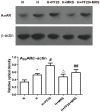Paeoniflorin inhibits pulmonary artery smooth muscle cells proliferation via upregulating A2B adenosine receptor in rat
- PMID: 23935939
- PMCID: PMC3728310
- DOI: 10.1371/journal.pone.0069141
Paeoniflorin inhibits pulmonary artery smooth muscle cells proliferation via upregulating A2B adenosine receptor in rat
Abstract
Paeoniflorin (PF), which is the main active ingredient in the root of Paeonia Radix, has many pharmacological effects. Here, we investigated the effect of PF on rat pulmonary artery smooth muscle cells (PASMCs) under hypoxic conditions and explored the mechanisms of the effects. The anti-proliferative effect of PF increased in a dose dependent manner. At the highest dose (20 μmol/L), the anti-proliferative effect of PF peaked at 24 h after administration. However, the selective A2B adenosine receptor (A2BAR) antagonist MRS1754 abolished it. PF increased A2BAR mRNA levels from 0.0763±0.0067 of β-actin mRNA levels (hypoxia group) to 0.1190±0.0139 (P<0.05) measured by Real Time Reverse Transcription-Polymerase Chain Reaction. A2BAR protein expression measured by Western Blot was also increased. PF inhibited the proliferation of PASMCs by blocking cell cycle progression in the S phase. These data indicated that activation of A2BAR might be involved in the anti-proliferative effect of PF on PASMCs under hypoxic conditions. The results suggested that a new mechanism of PF could be relevant to the management of clinical hypoxic pulmonary hypertension.
Conflict of interest statement
Figures






Similar articles
-
Neuroprotective effect of paeoniflorin on cerebral ischemic rat by activating adenosine A1 receptor in a manner different from its classical agonists.Br J Pharmacol. 2005 Oct;146(4):604-11. doi: 10.1038/sj.bjp.0706335. Br J Pharmacol. 2005. PMID: 16086036 Free PMC article.
-
Adenosine, Via A2B Receptors, Inhibits Human (P-SMC) Progenitor Smooth Muscle Cell Growth.Hypertension. 2020 Jan;75(1):109-118. doi: 10.1161/HYPERTENSIONAHA.119.13698. Epub 2019 Dec 2. Hypertension. 2020. PMID: 31786976 Free PMC article.
-
Tanshinone IIA inhibits hypoxia-induced pulmonary artery smooth muscle cell proliferation via Akt/Skp2/p27-associated pathway.PLoS One. 2013;8(2):e56774. doi: 10.1371/journal.pone.0056774. Epub 2013 Feb 21. PLoS One. 2013. PMID: 23437233 Free PMC article.
-
[Advance in studies on effect of paeoniflorin on nervous system].Zhongguo Zhong Yao Za Zhi. 2013 Feb;38(3):297-301. Zhongguo Zhong Yao Za Zhi. 2013. PMID: 23667997 Review. Chinese.
-
The resurgence of A2B adenosine receptor signaling.Biochim Biophys Acta. 2011 May;1808(5):1329-39. doi: 10.1016/j.bbamem.2010.05.016. Epub 2010 May 28. Biochim Biophys Acta. 2011. PMID: 20546702 Free PMC article. Review.
Cited by
-
Paeoniflorin protects diabetic mice against myocardial ischemic injury via the transient receptor potential vanilloid 1/calcitonin gene-related peptide pathway.Cell Biosci. 2016 Jun 1;6:37. doi: 10.1186/s13578-016-0085-7. eCollection 2016. Cell Biosci. 2016. PMID: 27252827 Free PMC article.
-
The Adenosinergic System as a Therapeutic Target in the Vasculature: New Ligands and Challenges.Molecules. 2017 May 6;22(5):752. doi: 10.3390/molecules22050752. Molecules. 2017. PMID: 28481238 Free PMC article. Review.
-
Beneficial Effects of Paeoniflorin Enriched Extract on Blood Pressure Variability and Target Organ Damage in Spontaneously Hypertensive Rats.Evid Based Complement Alternat Med. 2017;2017:5816960. doi: 10.1155/2017/5816960. Epub 2017 Jan 24. Evid Based Complement Alternat Med. 2017. PMID: 28243310 Free PMC article.
-
Effects of baicalin on collagen Ι and collagen ΙΙΙ expression in pulmonary arteries of rats with hypoxic pulmonary hypertension.Int J Mol Med. 2015 Apr;35(4):901-8. doi: 10.3892/ijmm.2015.2110. Epub 2015 Feb 25. Int J Mol Med. 2015. PMID: 25716558 Free PMC article.
-
Adenosine Receptors As Drug Targets for Treatment of Pulmonary Arterial Hypertension.Front Pharmacol. 2017 Dec 4;8:858. doi: 10.3389/fphar.2017.00858. eCollection 2017. Front Pharmacol. 2017. PMID: 29255415 Free PMC article. Review.
References
-
- Badesch DB, Champion HC, Sanchez MA, Hoeper MM, Loyd JE, et al. (2009) Diagnosis and assessment of pulmonary arterial hypertension. J Am Coll Cardiol 54: S55–66. - PubMed
-
- Stenmark KR, Fagan KA, Frid MG (2006) Hypoxia-induced pulmonary vascular remodeling: cellular and molecular mechanisms. Circ Res 99: 675–691. - PubMed
-
- Collis MG, Hourani SM (1993) Adenosine receptor subtypes. Trends Pharmacol Sci 14: 360–366. - PubMed
-
- Fredholm BB, Irenius E, Kull B, Schulte G (2001) Comparison of the potency of adenosine as an agonist at human adenosine receptors expressed in Chinese hamster ovary cells. Biochem Pharmacol 61: 443–448. - PubMed
Publication types
MeSH terms
Substances
LinkOut - more resources
Full Text Sources
Other Literature Sources

